The main goal of landscape design is to improve the site. Beautiful green spaces help to give the relief a picturesque look. Plants play a key role in landscape design, they are like paints of artists.
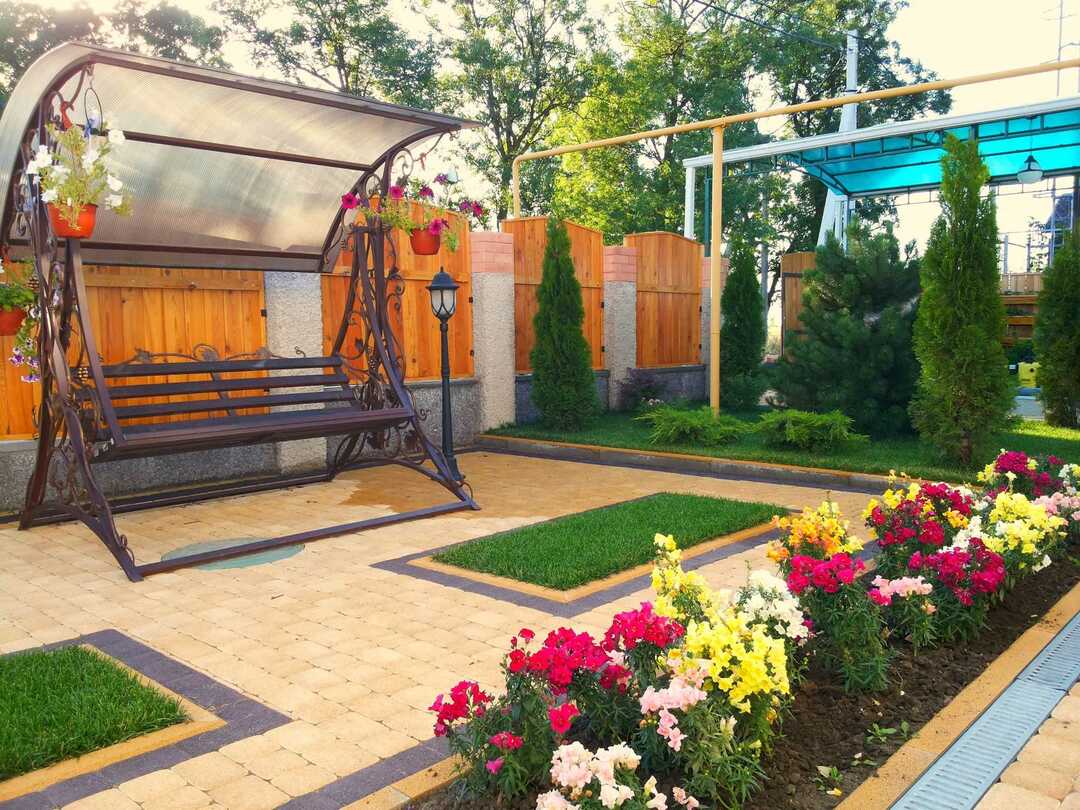
Landscaping organically combines the beauty of the surrounding space with the practicality of its use.
Features of the use of plants in landscape design
Content
- Features of the use of plants in landscape design
- The main types of plants for landscape design
- Trees
- Shrubs
- Ampel plants
- Aquatic plants
- Perennials
- The main types of flowers for landscape design
- Roses
- Irises
- Hydrangeas
- Aubrieta
- Phlox
- Peonies
- Possible other options
- Landscaping design options for a site using different plants and ways to combine them
- Tips and tricks for using plants in landscaping
- VIDEO: Choosing plants for landscape design.
- 50 options for combining plants in landscape design:
The task of the designer is to emphasize the peculiarity of the relief, when designing a garden, taking into account the decorative qualities of plants. The grass usually serves as the background of the composition. Habitous crops are chosen according to the shape and density of the crown, the growth rate, resistance to cutting are taken into account. Decorative deciduous trees are valued for the originality of the shape and color of the foliage. The combination of such crops with evergreen conifers always looks advantageous.
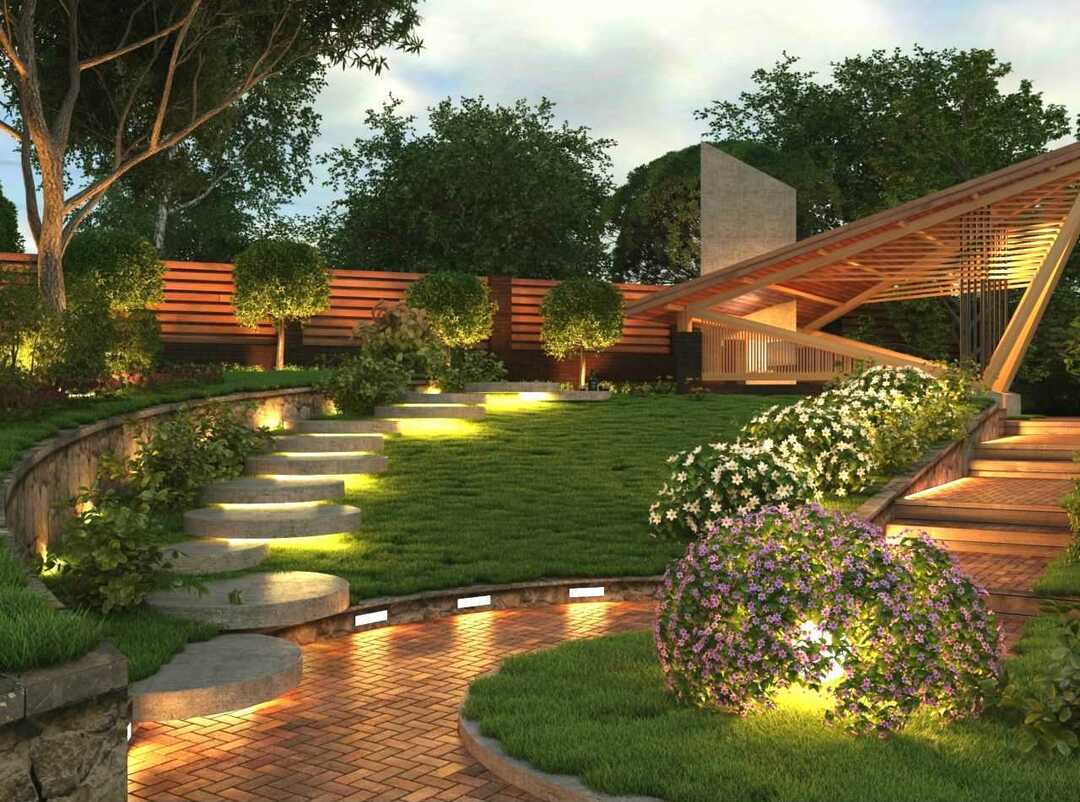
For many owners of country houses and cottages, the issue of decorating a personal plot is an important and relevant topic.
Flowering plants will help to make color accents; they are used for border decoration, single planting. Fruiting crops adorn the autumn garden, curly ones perfectly decorate the walls of the veranda, gazebos. Carpets visually smooth out the relief.
By combining plants in landscape design with various decorative qualities, it is possible to create harmonious compositions.
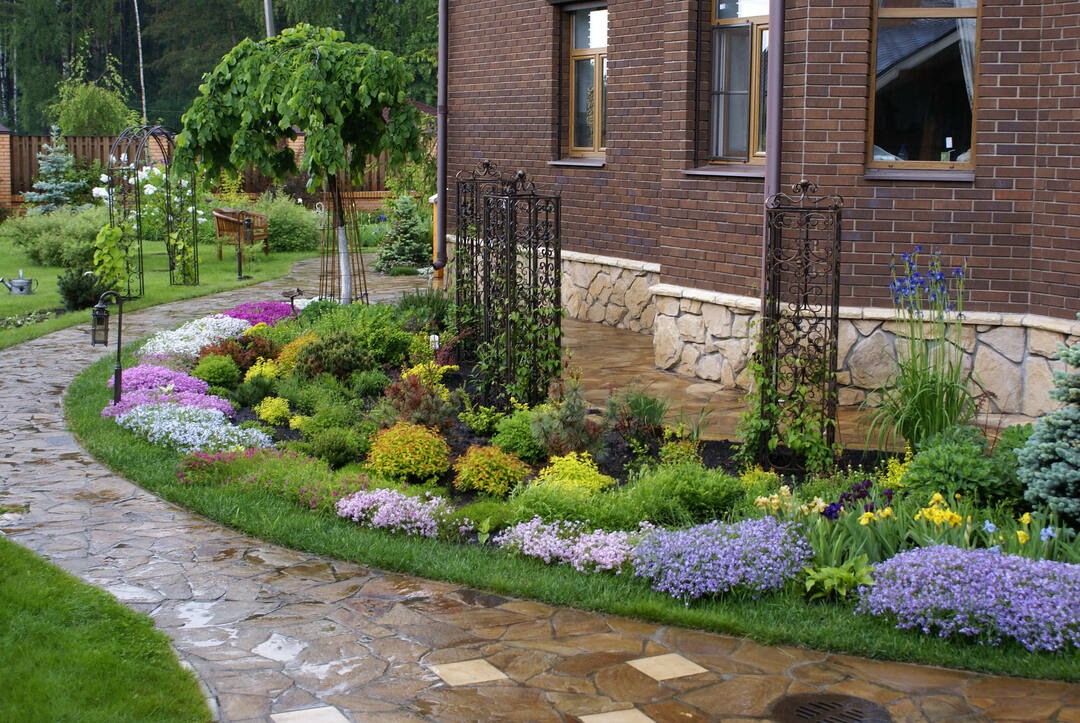
In this case, several factors need to be taken into account: climate, conditions, soil quality, the main characteristics of a particular plant.
The main types of plants for landscape design
It is customary to divide crops into several main groups according to tier, each plant species is assigned a specific role.
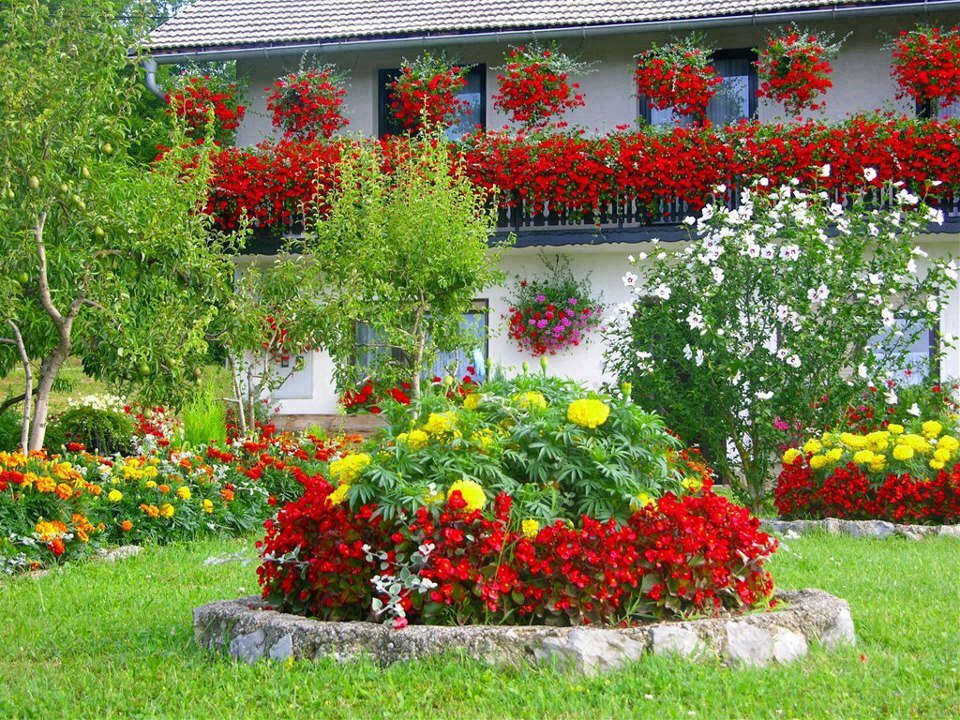
The correct choice of ornamental plants, their placement and skillful use of small architectural forms in landscape design are the key to an aesthetically attractive site.
Trees
A lonely tree always attracts attention. For gardening they grow:
low and creeping conifers (junipers, thuja, pines, spruces);
- from the fruit, the most decorative types of apple trees, pears, stone fruit trees with dense beautiful bark, even standard crown are chosen;
- deciduous are more often used for single planting;
- along the fence for the hedge, medium-sized species with a dense crown are chosen.
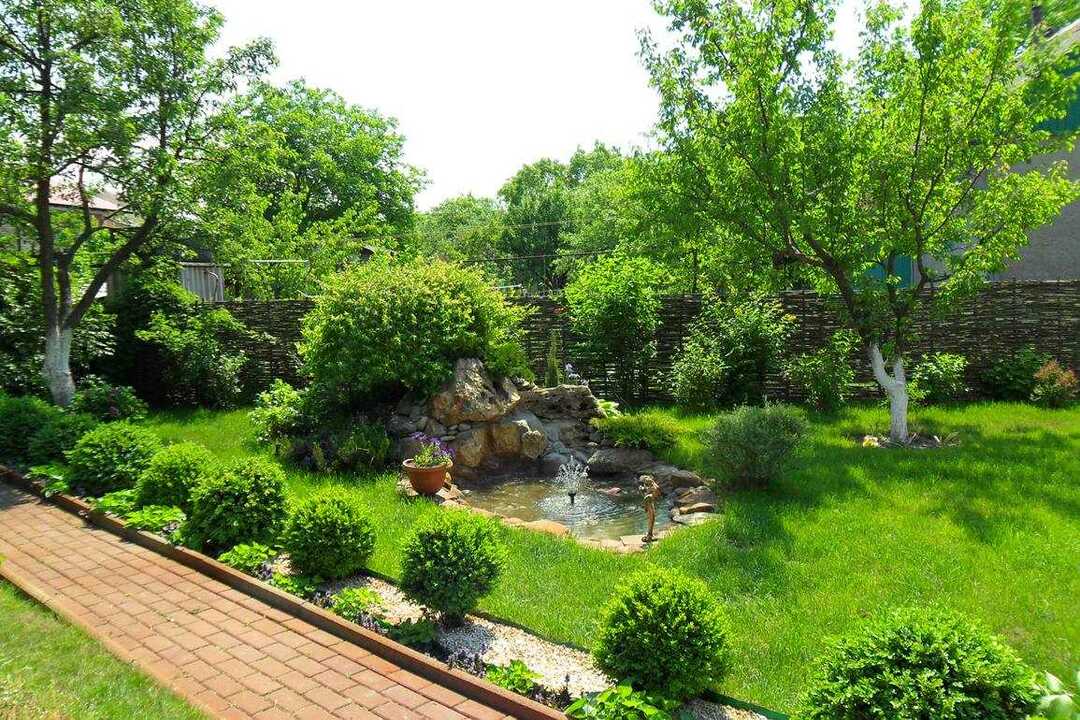
In landscape design, trees are the main material, they are used to complement an already created beautiful picture.
Trees are necessary for layered landscaping, conifers decorate rockeries, go well with flowering shrubs.
Note! Landings along the paths maintain the compositional rhythm, create shady alleys.
Shrubs
Group landings often become the axis of the composition. Single decorative views are used to create accents. For decoration, flowering shrubs are chosen, creeping forms and amenable to formative pruning. Shrubs are often placed next to trees, used as a connecting link with a combination of herbaceous plants, planting the site is divided into zones.
A beautiful landscape cannot be imagined without shrubs that delight with carved and variegated foliage that changes color in the autumn. For accents, lush flowering bushes and types of bright leaves and fruits are chosen.
When choosing crops, the size and direction of plant growth are taken into account. Expanding vertically resemble trees that grow in breadth - a good option for zoning planting.
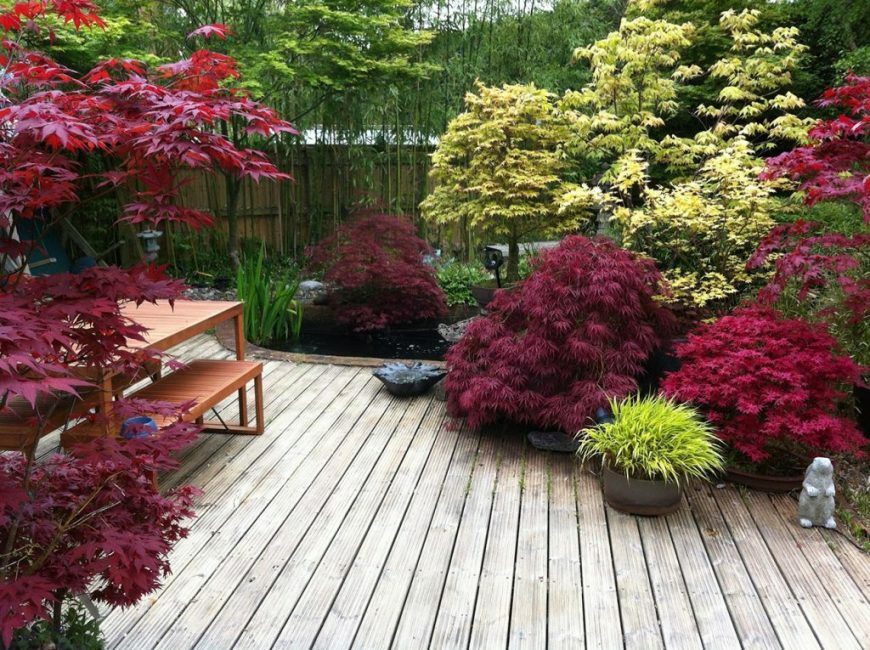
Plants and shrubs for landscaping should be very carefully selected in order to create a chic and complete composition on the site.
Important! It is better to plant low-growing shrubs in groups so that they do not dissolve in the overall composition.
Ampel plants
The name of the plant is derived from the word "ampel" (hanging pots). A wide variety of lianas are conventionally divided into two groups:
- curly ones are able to climb a support, a cord due to antennae or aerial roots;
- creeping ones direct shoots along the surface of the earth in different directions.
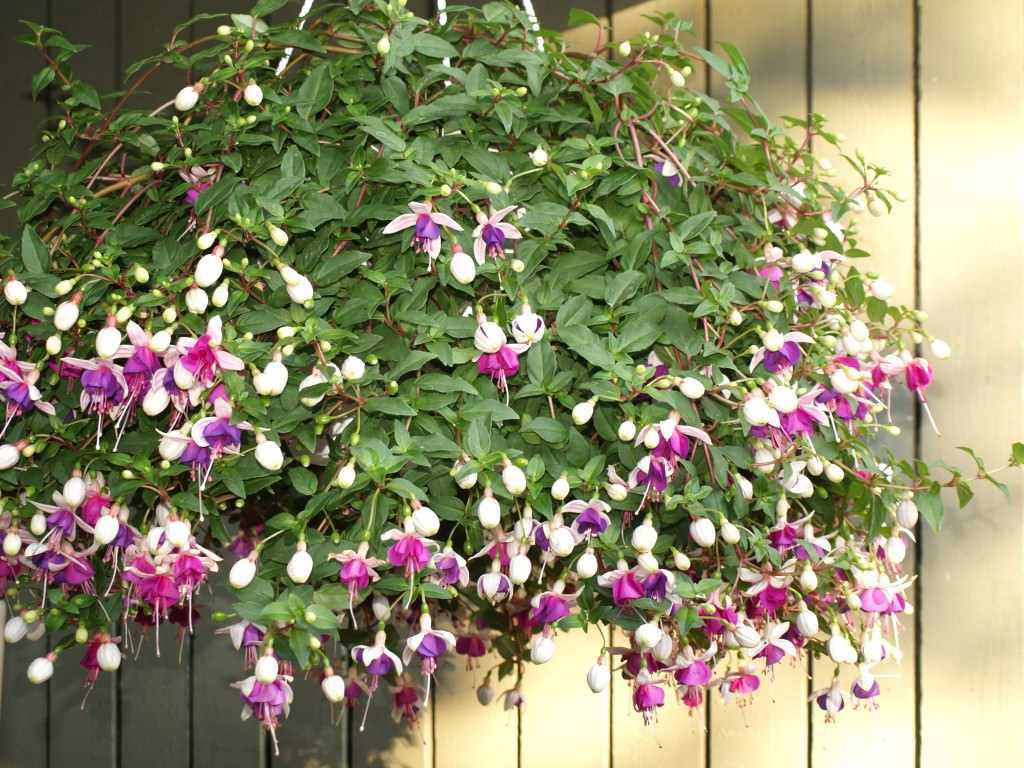
Ampel plants can be called the favorites of many gardeners without a shadow of a doubt.
Climbing cultures are used to decorate small architectural forms, fences. They create green canopies from plants that protect from the sun. Ampel plants decorate waterfalls, retaining walls, alpine slides.
Aquatic plants
Water lilies, calamus, duckweed and other plants with floating leaves regulate the gas composition of water and create a favorable environment for the inhabitants of reservoirs. Susak, blackhead, reeds, strengthen the banks with powerful roots, form beautiful thickets.
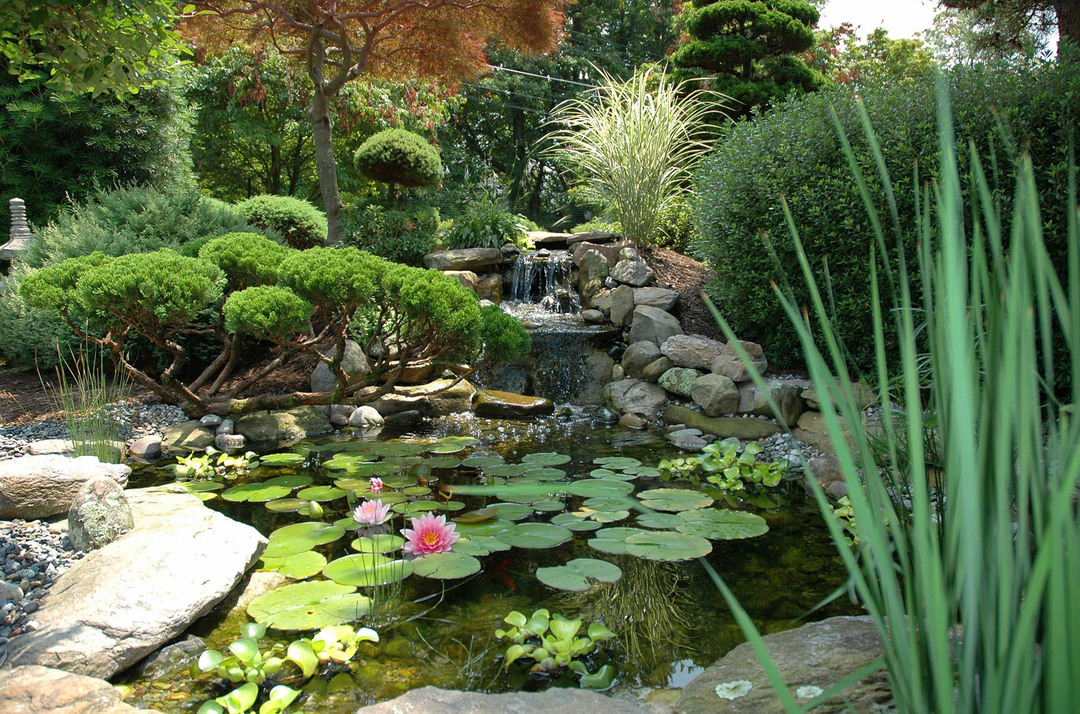
Pond decoration with plants.
Perennials
Unpretentious perennial grasses and herbaceous shrubs form a green cover in summer cottages and parks. Ground cover perennial crops are used as a background, color spots. Floral perennials are grown for border and zoning planting. There are a great many perennials, for landscape design they choose:
- water-loving;
- drought-resistant;
- light-loving;
- shade-tolerant.
Important! In hard-to-reach and remote corners of the garden, unpretentious frost-resistant species are planted, giving a small increase, resistant to pests and fungal infections.
The main types of flowers for landscape design
Flowering plants for compositions are selected with different flowering periods or flowers are planted that eject buds several times throughout the season. Popular perennials deserve special attention.
Roses
Rose breeders have been breeding roses for several centuries. The bushes bloom in two phases with a break from 5 days to 2 weeks.
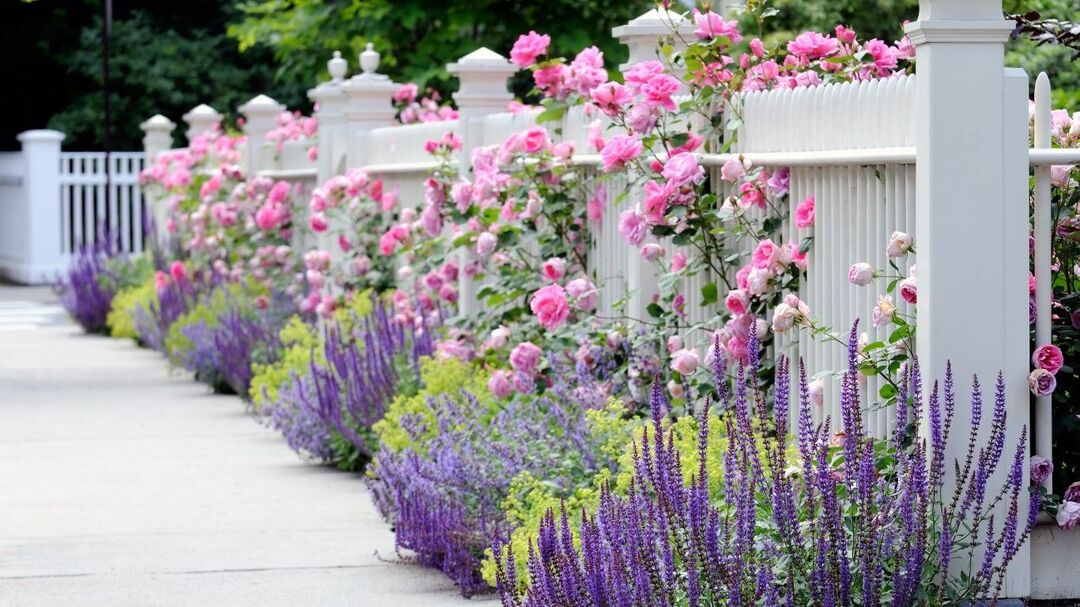
Roses rightfully occupy a special position in the garden and in the garden.
Hundreds of varieties have been bred, which are usually divided into groups according to species characteristics:
- Hybrid tea has a special aroma, bushes 60–80 cm high are suitable for group and single planting. The buds are ordinary, double, collected in inflorescences.
- Polyanthus - continuously blooming. The height varies from 40 cm to 1.5 meters, the color of the buds is predominantly red, the size of the flowers is up to 4 cm.
- Floribundas are valued for long and abundant flowering, lush clusters of flowers (in inflorescences up to 30 medium-sized buds).
- Climbing roses form shoots up to 5 meters long; for the decoration of plots for group planting, re-flowering highly branching varieties are often chosen.
- Standard stocks are grown by grafting 2-3 rootstocks on the stock to form a beautiful dense crown. The stem is made with a height of 80 to 120 cm, must be tied to the support.
- ground cover - small-leaved, widespread bushes with a spreading crown.
- Border - medium-sized of various types, the height of the bush is 30-50 cm.
- Miniature - undersized, from 10 to 30 cm in height. The buds are terry or cupped, grow up to 3 cm. The leaves are small, dark green.
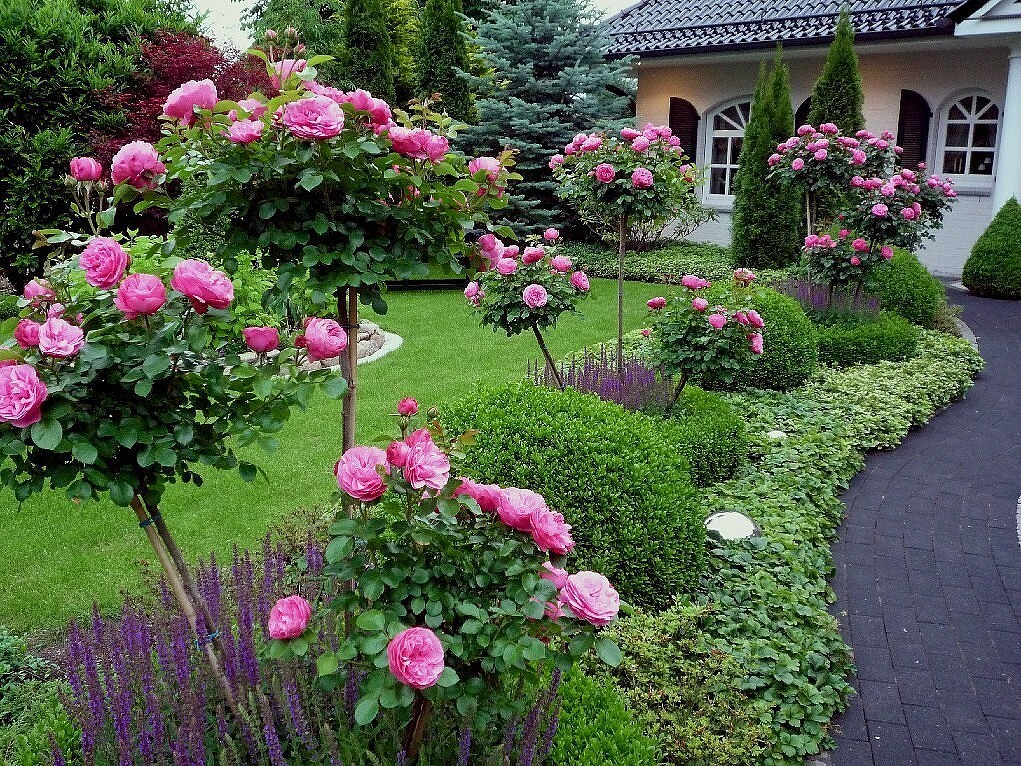
In landscape design, roses are the central decorative element.
Important! Recommendations for the design of the rose garden: combine white, pink, red roses. Yellow and cream are best planted separately, singly or in groups.
Irises
Bearded and beardless irises differ in growing conditions. Varieties with villi on the petals are sun-loving, drought-resistant. Flowers with yellow spots on the petals prefer to grow near water bodies, they like partial shade. Early irises are valued for their rare blue or violet color and are suitable for group planting. Hybrid varieties are yellow and yellow-brown in color, above blue-violet.
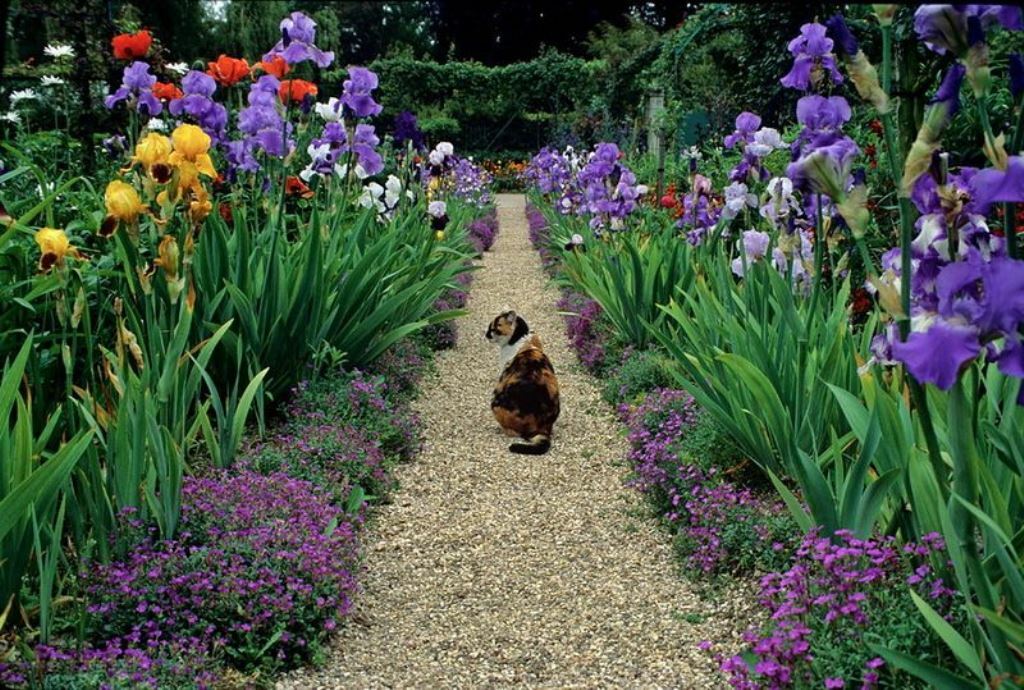
They are equally harmoniously combined with other flowers and are successfully used to decorate flower beds as a monoculture.
Hydrangeas
Shrubs 1–2 meters high are prized for their lush flower caps. Main varieties:
- large-leaved hydrangea with globular inflorescences;
- paniculate - with trapezoidal;
- tree-like - with white panicle-shaped inflorescences;
- oaky changes the color of the buds from white to purple;
- petiolate - a curly variety of hydrangea, with white-pink panicles of inflorescences.
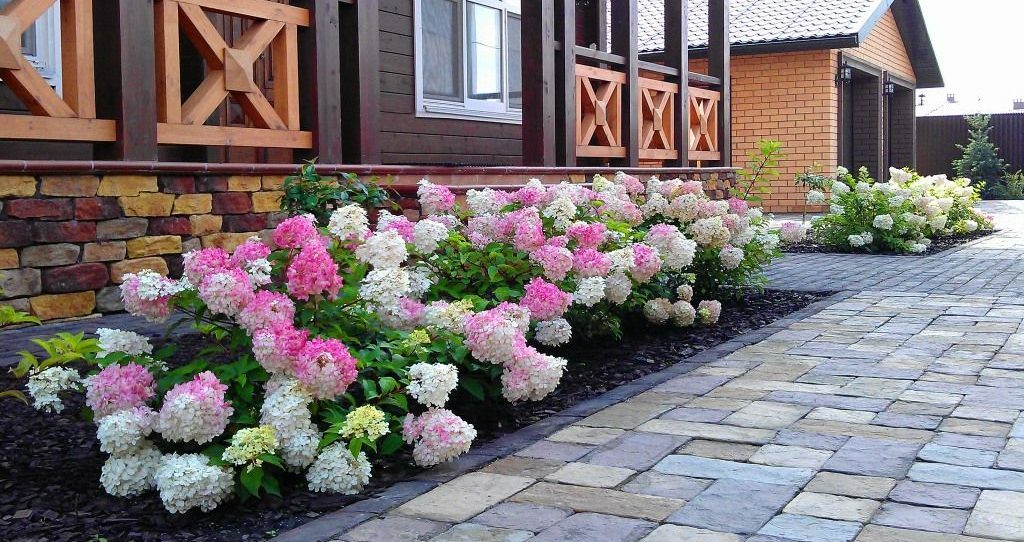
Hydrangea is a favorite of many gardeners, it makes the site bright and unforgettable.
Important! The color of hydrangeas depends on the acidity of the soil. A slightly acidic soil is desirable.
Aubrieta
Aubrieta or aubretia is an evergreen frost-resistant perennial plant with inflorescences of pink, white, purple (cascading) or azure color (deltoid). It blooms in two stages: in late spring and early autumn.
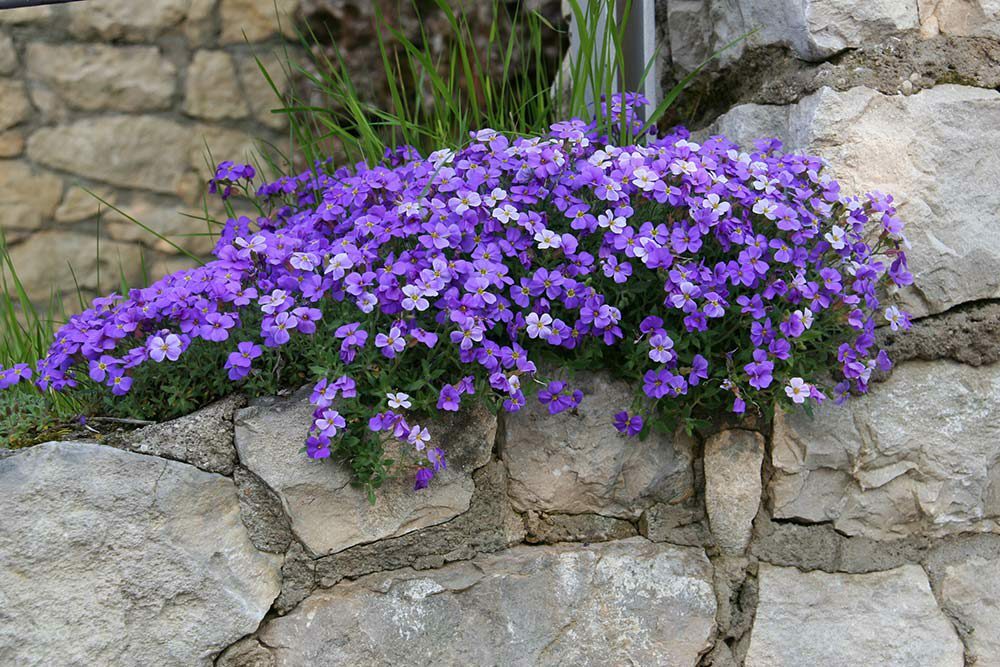
Aubrieta is a popular ornamental plant.
Phlox
In summer cottages, phloxes of various colors are often grown. Plants vary in flowering time:
- paniculate flowers in July – September;
- spotted - in June July;
- adorable - short, early blooming (May - June).
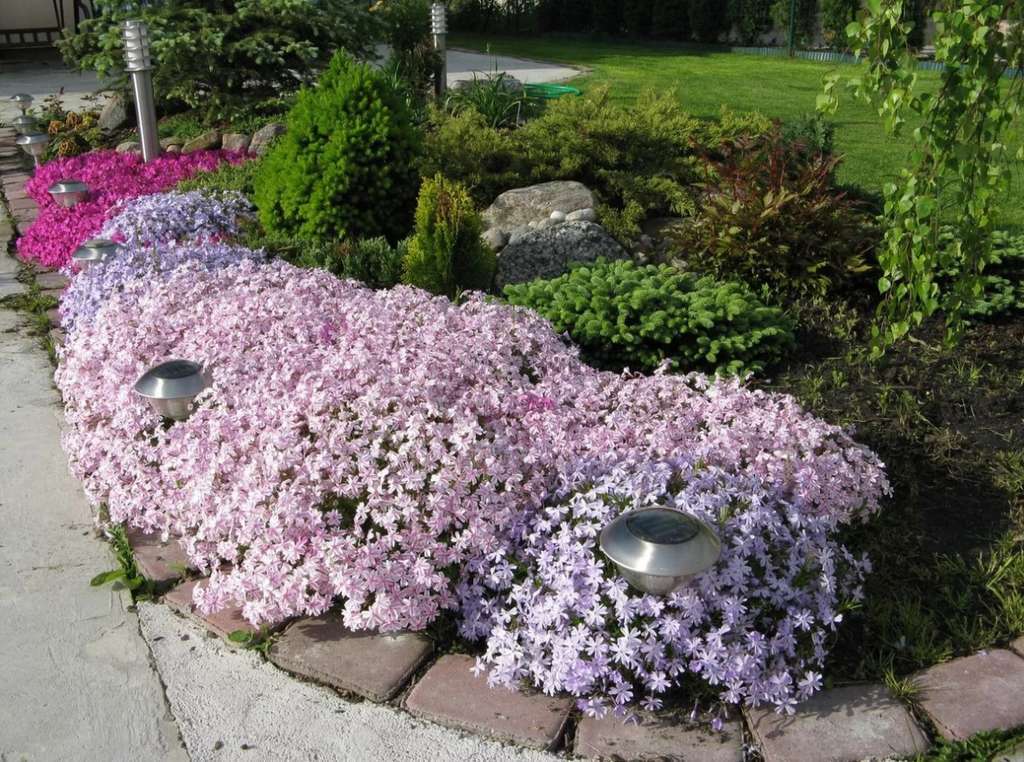
Phlox is a perennial ornamental flower.
Usually, different varieties are grouped in one flower bed, plants are used for compositions.
Peonies
They bloom in the first half of summer, from May to July. Medicinal and narrow-leaved are non-double and semi-double. Japanese - with colors of the transitional type. Terry - with a lot of petals. Anemone resembles asters, with two types of petals. Peonies are planted singly or in groups, combining peonies with different flowering periods.
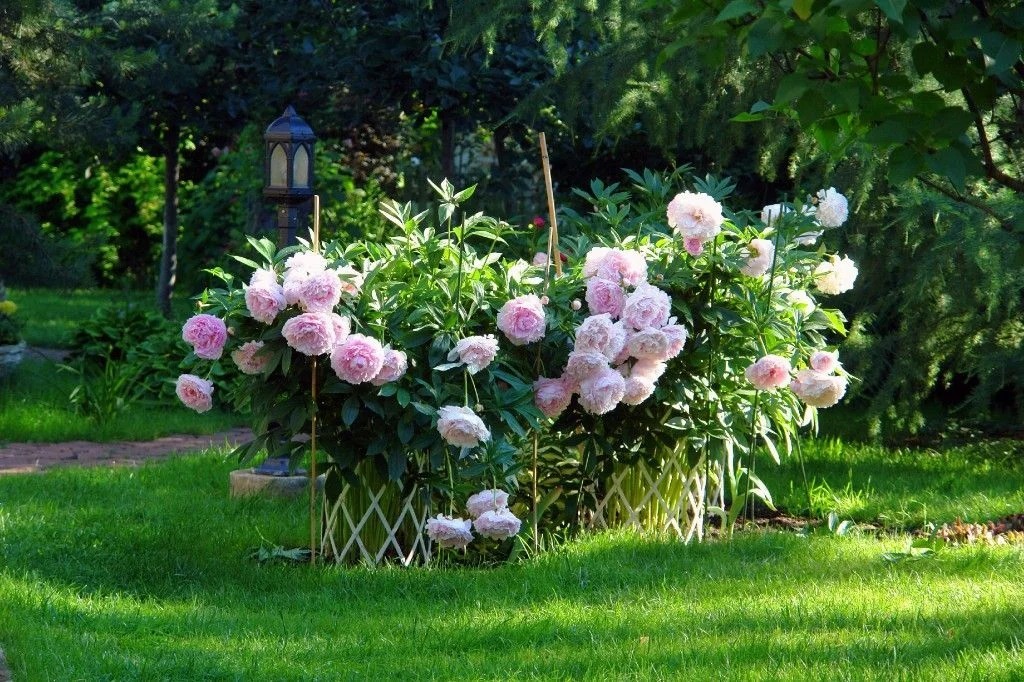
Everything is beautiful in herbaceous peonies - a luxurious flower, a delicate aroma, a beautiful bush with decorative foliage.
Possible other options
For decorative gardening, daffodils are bred, bulbous perennials differ:
- gramophones;
- a skirt at the core;
Terry daffodils are especially beautiful. Japanese lily bushes resemble dense sedge. Delphiniums produce tall sultans with funnel-shaped buds.

The advantage of this type is the ability to update the landscape design every season.
Landscaping design options for a site using different plants and ways to combine them
The combination of colors is:
- partner, when cultures of the same decorativeness coexist, a motley pattern is created;
- background, when one culture dominates, the second creates a bright spot.
When creating a landscape composition, it is taken into account:
- decorativeness of culture;
- plant height and width.
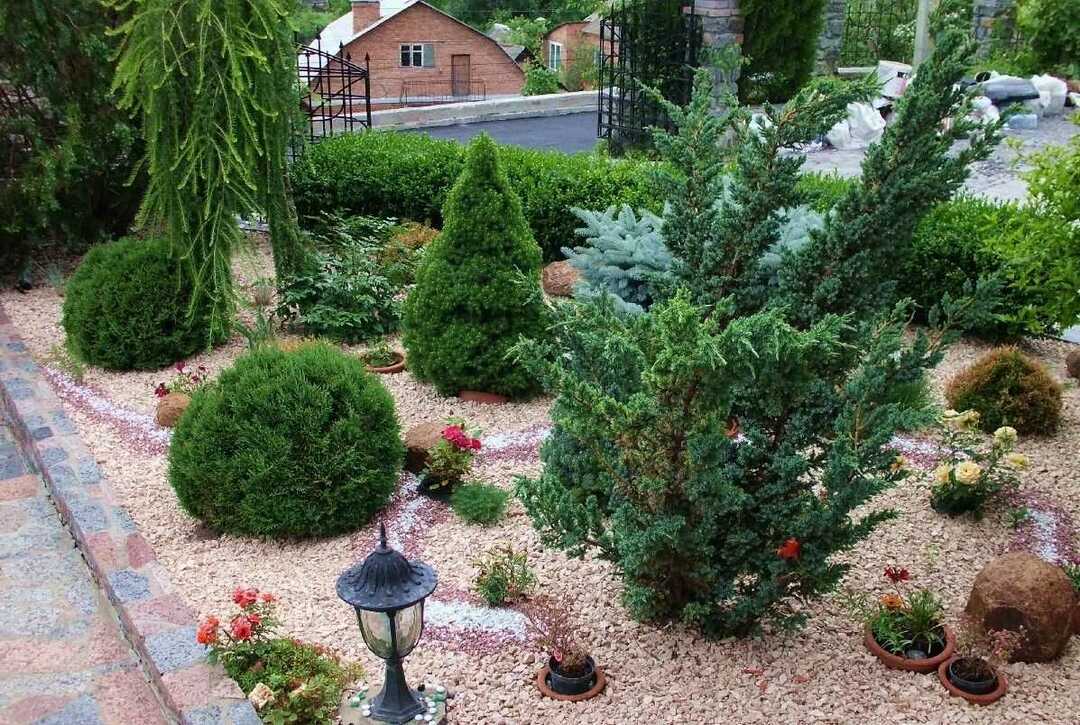
Decorating a plot with your own hands, without resorting to the help of professionals, is a feasible activity even for a novice gardener.
Experts choose crops not only in appearance, but also in their ability to grow in given conditions. For flooded areas, choose moisture-loving grasses, flowers, trees and shrubs, for sun-drenched areas - sun-loving, drought-resistant. It is necessary to take into account the illumination, climatic conditions. Creating compositions, designers choose from the categories of plants crops that are resistant to diseases, undemanding to care. Only with such vegetation will the site look well-groomed.
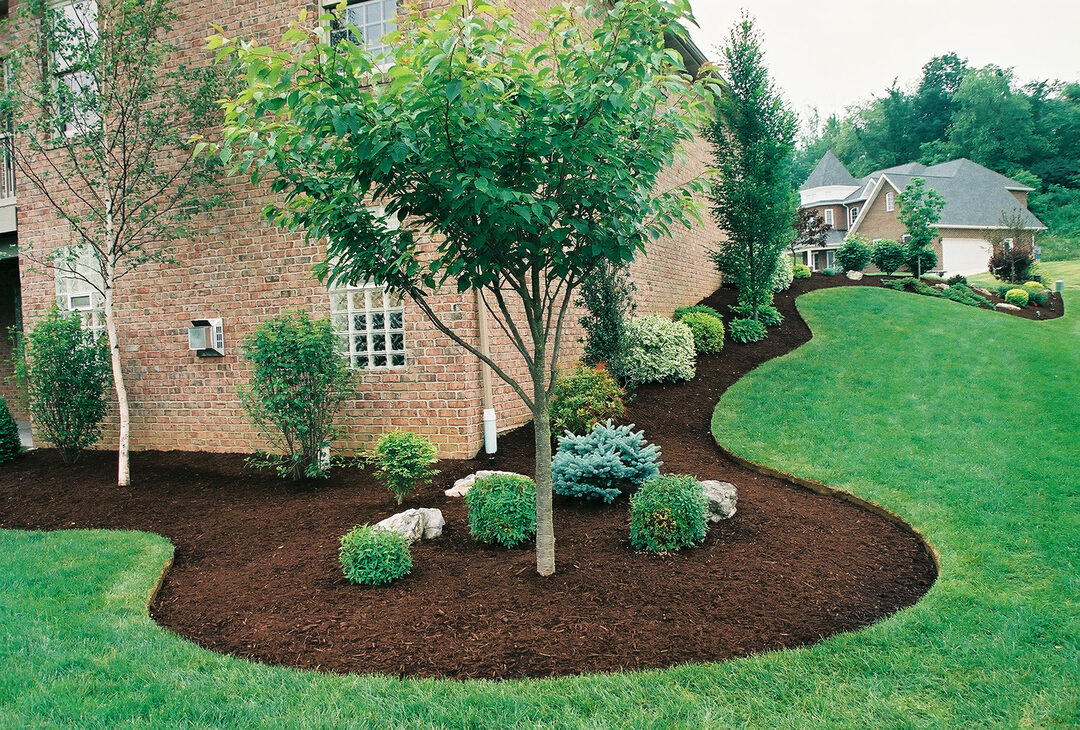
Among the abundance of plants and flowers, you will definitely choose those varieties that will delight your eye before the onset of the first cold weather.
Designers combine different types of crowns (sphere, cone, trapezoid), make tiered and single-level compositions.
Tips and tricks for using plants in landscaping
Beds with perennials add annual flowers of a different flowering period. Crops with bicolor or variegated buds are best planted on a solid background. Do not overload the composition with paints. Flowering plants are interspersed with coniferous and white-leaved shrubs. The spacing is observed between the views so that there is harmony in the design.
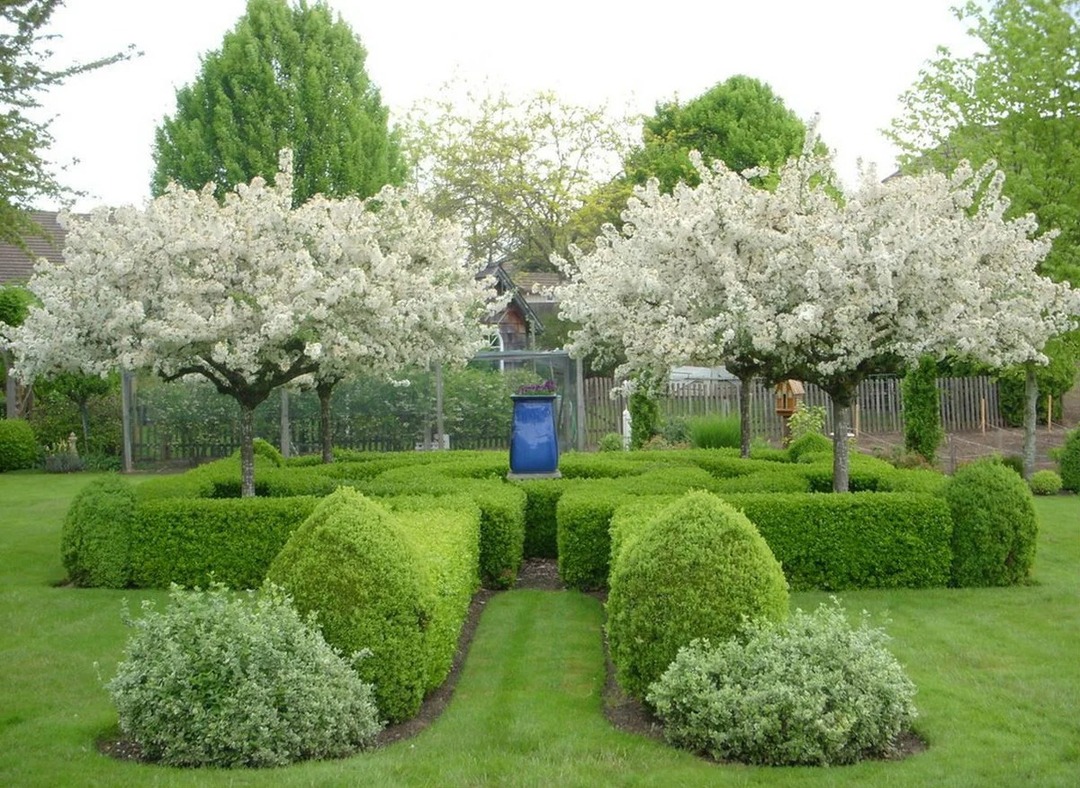
A properly designed territory creates a good mood, delighting those around you with its unique beauty.



